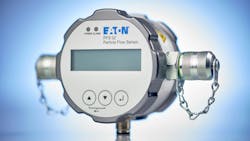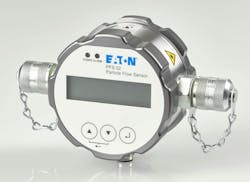Eaton Particle Flow Sensor Detects Oil Contaminants
Eaton’s Filtration Division has developed a compact particle flow sensor to provide continuous contamination monitoring of hydraulic and lubrication oils. The PFS 02 sensor is able to provide immediate and accurate diagnoses of contamination levels within a system.
Contaminants, no matter how small, can cause major performance issues if they get into hydraulics and other systems. But with a sensor like the PFS 02 installed in a system, the chances of these performance issues occurring and causing unplanned downtime can be reduced.
Sending alerts to machine operators when particle concentration rises allows them to address the issue as soon as possible, minimizing downtime as well as larger maintenance problems.
“We see an increasing use and demand for such sensors,” said Simone Ortner, Hydraulic Filtration Engineering and Product Manager at Eaton Filtration. “In our opinion, there are several factors contributing to this. The sensors help prevent failures and extend the lifespan of machines. Additionally, by detecting wear early, expensive repairs and downtime can be reduced, thereby saving costs.”
How Eaton Achieved a Compact Particle Flow Sensor Design
The PFS 02 particle flow sensor is an in-line device which can detect solid particles starting from a size of 4µm. To do so, Ortner said it operates based on the light blockage principle.
Quick Stats about the PFS 02 Particle Flow Sensor
- Operating pressures up to 6,000 psi (420 bar)
- Sensor and evaluation unit integrated into a single device
- Two Minimess® connections for easy connection
- Installation in new and existing systems
- Generally installed in the offline circuit
- Internal memory for storing measurement results
- Can be used for continuous or periodic monitoring
“A laser beam is directed through a measurement cell. On the other side, there is a photodetector. The output signals of the photodetector depend on the particle size,” she explained. “Through appropriate electronics, the output signals are converted into a count and size.”
When developing the sensor, there were a number of design challenges Eaton had to overcome to ensure it would meet customer requirements. Ortner said these included ensuring the sensor’s accuracy and sensitivity as well as integrating these features into a compact housing.
Space is at a premium on many of today’s machines due in part to the number of technologies being integrated into them, necessitating the availability of components which are more compact in size. Not only do compact components help to reduce space claim but they are also typically easier to install.
Previously, Eaton’s particle measuring devices consisted of two separate components — the sensor and the evaluation unit. But the PFS 02 brings them together into a single unit. To achieve this, Ortner said the company used newer and more compact electronic components.
In addition, she said an additional flow sensor is no longer used. “We now determine the flow rate in a different way,” she said. “This has allowed us to save significant space and integrate everything into a single compact housing. The advantage is that the user only needs to install one component.
“Additionally, the improved technology in a single housing unit provides enhanced accuracy,” she noted.
The company also set out to design a particle flow sensor capable of operating at pressures up to 420 bar (6,000 psi). Ortner said this required extensive testing and optimization of the latest technologies.
By having the ability to work at such high pressures, the particle flow sensor can be used in a wide range of mobile and industrial machinery applications such as construction equipment and test benches. “It can also be used in gearboxes for the early detection of wear,” she said.
Digital Communication Enables Proactive Maintenance
According to Ortner, extensive communication capabilities were incorporated into the PFS 02 sensor based on customer feedback. Doing so allows measuring results to be provided via a serial or CANbus interface, she said.
An analog 4-20 mA interface is included on the sensor as well, enabling customers to use the output interface that best suits their needs. Ortner said that a benefit offered by the PFS 02 sensor is that it “outputs only one 4-20 mA signal, compared to the three signals in our previous models, reducing the need for additional analog inputs.”
Measurement results are shown on the sensor device’s graphic display to provide easy monitoring for users. Results can be displayed according to ISO 4406:99, SAE AS 4059, NAS 1638 and GOST 17216 standards.
With these communication capabilities, machine users can be better prepared to address issues as they arise to help minimize unplanned downtime and maintenance — both of which can be costly and time consuming. And by addressing contamination issues early, wear and tear can be reduced, leading to longer system and machine life.
Through its creation of the PFS 02 particle flow sensor, Eaton is helping address industry challenges associated with reliability and downtime by providing customers with a way to detect the presence of contaminants in hydraulic fluids and lubricant oils before they cause performance issues or system failures.
About the Author
Sara Jensen
Executive Editor, Power & Motion
Sara Jensen is executive editor of Power & Motion, directing expanded coverage into the modern fluid power space, as well as mechatronic and smart technologies. She has over 15 years of publishing experience. Prior to Power & Motion she spent 11 years with a trade publication for engineers of heavy-duty equipment, the last 3 of which were as the editor and brand lead. Over the course of her time in the B2B industry, Sara has gained an extensive knowledge of various heavy-duty equipment industries — including construction, agriculture, mining and on-road trucks —along with the systems and market trends which impact them such as fluid power and electronic motion control technologies.
You can follow Sara and Power & Motion via the following social media handles:
X (formerly Twitter): @TechnlgyEditor and @PowerMotionTech
LinkedIn: @SaraJensen and @Power&Motion
Facebook: @PowerMotionTech



